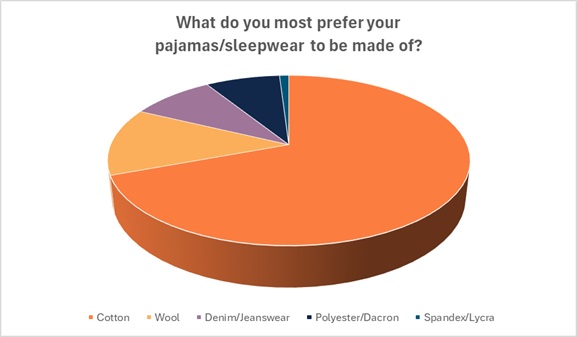Temperatures recently began cooling across much of the United States, even bringing frost warnings to parts of the Midwest. Inevitably, pumpkin spice everything starts popping up and thoughts turn to getting cozy indoors, especially in comfy pajamas and loungewear. And many brands and stores are appeasing consumer preference for cotton products to carry them through the fall and winter months.
From flannel and poplin pajamas to pull-on bottoms, soft tees, and cozy cardigans and hoodies, makers are leaning into the natural benefits that cotton offers. Even more, these products check the sustainability box that both brands and shoppers want.
Loose, lightweight clothing can help you stay cooler at night…Choose cotton fabrics over polyester, which can stick to your skin if you sweat.
Better Sleep Council
Nearly 6 in 10 U.S. consumers (57 percent) say sustainability/environmental friendliness has an influence on their clothing purchase, according to the Cotton Incorporated Global Sustainability Study, U.S. (n=1,013). Further, the majority of shoppers say organic cotton (82 percent), recycled cotton (80 percent) and cotton (79 percent) are safe for the environment. That compares to 41 percent for polyester and 32 percent for rayon.
“At Goldie, sustainability is built into every decision we make,” said Goldie Lewinter’s Debbie Rudoy, founder and creative director, in an interview with the Lifestyle Monitor™. “[It’s] produced in small batches with a low-impact approach –partnering with local communities, minimizing our carbon footprint and creating pieces designed to last. For us, it’s not just about how it looks, it’s about how it feels.”
Over 8 in 10 consumers (84 percent) say apparel made from cotton is the most comfortable, according to the Cotton Incorporated’s Lifestyle Monitor™ Survey 2025 (n=500). And when it comes to pajamas, 72 percent of consumers prefer cotton, according to Cotton Incorporated’s 2023 Global Lifestyle Monitor™ Survey (U.S. data, n=1,000). Fully 80 percent of consumers own at least one pair of pajamas, and most shoppers (53 percent) own one to five pairs, according to Cotton Incorporated’s 2025 Lifestyle Monitor™ Survey (n=500).

It’s not just consumers that prefer cotton sleepwear; the Better Sleep Council recommends the fabric, as well.
“Loose, lightweight clothing can help you stay cooler at night,” the Council advises. “Choose cotton fabrics over polyester, which can stick to your skin if you sweat.”
This holiday season, Gap is ready to meet the demand for cotton sleepwear. The retailer says it will be offering a range of pajama styles “focused on family matching, and designed for comfort and versatility” across its women’s, men’s and kid’s divisions. The collection includes 100 percent cotton flannel and breathable poplin styles to mix and match, in an assortment of 15+ classic and seasonal colorways. Gap’s holiday sleep assortment will begin to roll out starting in October through December.
Brands that get it right stand to profit. Consider that the global sleepwear market stood at $13.4 billion in 2023 and is projected to reach $32.6 billion by 2033, according to a report from Market.US. Women dominate the category, owing to “tailored offerings and the demand for stylish yet comfortable options.” Additionally, North America leads sales with a 35 percent market share, driven by high consumer spending and “robust retail infrastructure.” Cotton leads the material type for the category, “owing to its breathability and suitability for all climates,” the report states.
Cotton Incorporated has further improved on the natural benefits of cotton with the development of WICKING WINDOWS™ technology. WICKING WINDOWS™ technology provides moisture management benefits and can be combined with a cooling phase change material (PCM) that can keep the wearer cooler. When exposed to heat and moisture, the treated fabric is successfully kept five degrees cooler than untreated cotton fabric. It also performed as well as or better than competitive synthetic phase-change fabrics.
Of course, plenty of people choose to sleep, nap or relax in loungewear. The global market for loungewear was valued at about $4.6 billion in 2024 and is expected to reach about $8.5 billion by 2032, according to a report from Stellar Market Research. The company says the loungewear market is dominated by cotton and attributes this to “customer preferences for comfort, breathability and versatility in the loungewear market. Cotton possesses natural properties making it a preferred choice among consumers preferring softness and moisture-absorbing properties in their loungewear, aligning with the target market demands.” The report said cotton loungewear is “embedded in offering both quality and affordability, making it accessible to a wide range of customers.”
The SMR report goes on to say the reliability and trustworthiness of cotton loungewear has also resulted in brand loyalty for makers that choose to work with the natural fiber. This appeal crosses various age groups and genders, the report states. “Additionally, the continuing popularity of cotton loungewear, combined with its timeless nature, has enabled it to retain a strong market presence even as fashion trends change, driving the loungewear market.”
Loungewear includes hoodies, tees, and relaxed bottoms. A quarter of all consumers (28 percent) say sweats and joggers are a top choice when they just want to be comfortable or are hanging out at home (26 percent), according to the Global Lifestyle Monitor™ 2023 (U.S. data, n=1,000). And after denim jeans (38 percent), consumer wore sweats (29 percent) and athleisure bottoms (27 percent) – which includes leggings – the most in the past month, according to Cotton Incorporated’s 2025 Consumer Sentiment Survey, Wave 1-3 (n=2,913).
Goldie’s bestsellers include cotton tees, tanks, cardigans, and casual pants. Rudoy says the pieces are rooted in unparalleled softness and crafted with intention.
“Our styles are effortlessly versatile,” Rudoy said, “designed to feel like loungewear, yet polished and refined enough for day-to-night-to-evening dressing.”
